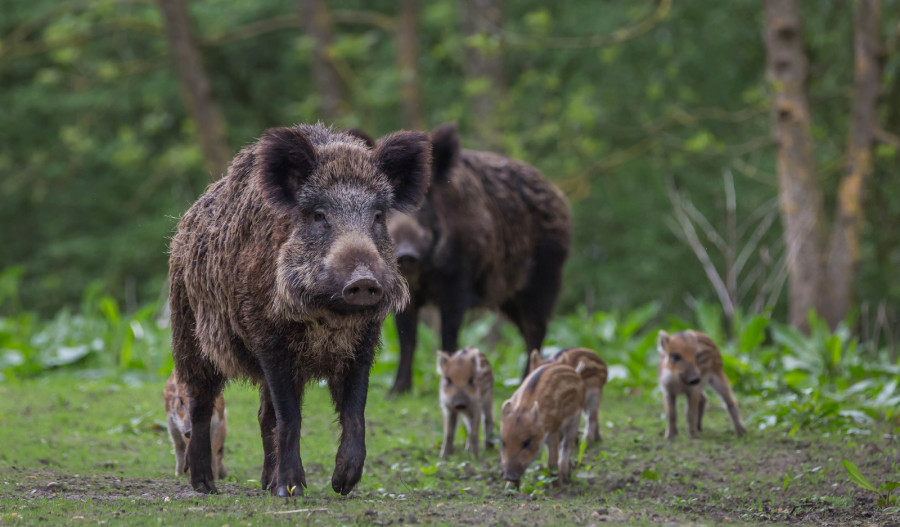National
Government removes penalties for killing wild boar, raising concern among conservationists
After complaints from farmers that the animals were destroying their crops, the wild boar has been listed as a ‘pest’ and can thus be captured and killed.
Chandan Kumar Mandal
The government’s decision to enlist wild boar as a ‘pest animal’ and allow its capture and killing could result in uncontrolled culling of the animal, fear wildlife conservationists.
The recent change to the existing National Park and Wildlife Conservation Rules (1974) allows communities to capture and even kill wild boars if the animals enter their agricultural farms and damage crops.
But wildlife conservationists have warned that the new provisions could lead to the rampant killings of wild boars, which are prized for their meat. There are also chances that the decision could be misinterpreted as encouragement to kill the animal, they said.
“People are already hunting wild boar and raising them at home,” said Raju Acharya, a wildlife conservationist. “We cannot rule out that the wrong message will be sent to communities that wild boars are no longer protected. And furthermore, people can always say that they killed the animal because it was destroying their crops.”
According to the Ministry of Forests and Environment, the wild boar was included on the list of pest animals—which is a category of animals that cause agricultural damage and other losses to local communities—after following complaints that the animal was entering farms and damaging crops at an unprecedented level.
According to Sindhu Prasad Dhungana, spokesperson for the Forest Ministry, they have received multiple complaints about agricultural damage by five animals—wild elephants, leopards, wild boar, blue bull and monkeys.
“For now, we have included wild boars in the pest animal category as they are causing massive damage to crops,” Dhungana told the Post. “Inclusion of the wild boar in this category means that these animals can be chased away or captured—and even killed during the attempt to capture.”
Studies have shown that pest animals threaten native animals because they hunt and prey on native species and compete for food and habitat. Pest animals are normally controlled around the world as they tend to affect agriculture, the environment and heritage sites.
As per the latest provisions, farmers cannot intentionally hunt the wild boars. Farmers or local communities first need to chase away or capture the animals alive and release them. But if they are killed in the process of capturing or chasing away the boars, farmers will not be penalised.
“If the animal dies while trying to capture it, the details of the incident must be collected in the presence of five persons, including representatives from the ward office,” said Dhungana. “The meat of the animal can then be consumed by locals if they so desire by paying a certain amount to the authorities as per the weight of the dead boar.”
But wildlife conservationists say that this could lead to the unrestrained culling of an animal that is already in demand for its meat.
According to Karan Shah, a retired professor of zoology and former chief of the National History Museum at Tribhuvan University, the debate over enlisting a few species as vermin—animals that destroy crops or livestock and spread diseases—had started nearly two years ago, when an amendment to the National Park and Wildlife Conservation Rules was first being proposed.
“I had proposed declaring a few subspecies of rats, porcupines and monkeys as vermin, but that was not done,” said Shah. “Now, they have decided to allow the killing of wild boars, which will only promote the rampant killing of the species.”
Wild boars are not protected animals per se. The National Park and Wildlife Conservation Act only enumerates a total of 26 mammals as protected species. But it is still illegal to kill wild animals that are not on the list of protected species, as per the National Parks and Wildlife Conservation Act-1973. The wild boar is listed as “least concern” on the IUCN red list of threatened species.
But with boars already being killed for their meat, conservationists fear that the government’s decision could lead to the species being threatened.
“If some communities complain about problems caused by wild boars, the authorities should first conduct a study on the extent of the problems and how to manage them,” said Shah. “We cannot kill all of the boars. A proper plan executed by a local committee could be useful for dealing with pest animals.”
Forest Ministry officials, however, say that the prohibition on killing boars has only been lifted for this fiscal year and its effectiveness will be reviewed.
“Chances of misuse are minimal because the capture and killing of wild boars must be reported to the authorities, who will examine everything,” said Dhungana.
However, wildlife conservationists are sceptical of the effectiveness of monitoring, especially as poaching of wild animals continue across the country.
“Who will decide whether the wild boar was actually in the field and damaging crops?” said Acharya, who is also executive director of Friend of Nature Nepal, an organisation that works with the environment and in wildlife conservation. “People have been secretly killing wild boars, but now, they can kill boars on the pretext of damage to their crops.”




 8.12°C Kathmandu
8.12°C Kathmandu













%20(1).jpg&w=300&height=200)

